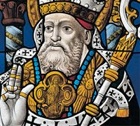Neri di Monte, who was a glass worked from Perugia, was documented in a team led by his uncle, Francesco di Baronio that worked on the stained glass of St Peter’s, Rome in 1450-3. (This team also included “Bartolomeo di Perugia, who was probably Bartolomeo Caporali).
After his uncle’s death in 1470, Neri di Monte became the leading artist in his field in Perugia.
Perugia
Documented glass by Neri di Monte in Perugia included a number of works that have been lost, including:
-
✴in the Cappella dei Priori (1460-1), to designs by Benedetto Bonfigli;
-
✴in the refectory of Palazzo dei Priori (1484); and
-
✴in the nunnery of Sant’ Antonio da Padova (1480-8).
Stained Glass in the Duomo (ca. 1484)
The document that commissioned the stained glass of the tribune of the Duomo of Foligno from Neri di Monte in 1485 required him to take as his model the stained glass of the “Cappella del Vescovo” in the Duomo of Perugia. This has to be the stained glass of the Cappella di Sant’ Onofrio, which Bishop Jacopo Vannucci had established in 1481. This glass in Perugia is also attributed to Neri di Monte, and its design is attributed to Bartolomeo Caporali.
The glass was removed in the 18th century and sold to the friars of San Francesco, Assisi in 1765 and much of it was reused in the Upper Church. All of the glass that had been reused in San Francesco was removed in ca. 1945, in a restoration that aimed to reproduce the original appearance of the church. The surviving panes from Perugia, which are now in the Museo del Tesoro di San Francesco [although not displayed ??] depict:
-
✴from the upper register:
-
•a fragment of St John the Baptist;
-
•the Madonna and Child; and
-
•St Laurence; and
-
✴from the lower register:
-
•St Onuphrius;
-
•St Jerome
-
•St Herculanus.
Assisi
Panels from stained glass windows in Perugia and Foligno, which were subsequently used in San Francesco, Assisi, are now in the Museo del Tesoro di San Francesco:
-
✴panels (ca. 1484) from the Cappella di Sant‘ Onofrio in the Duomo of Perugia (above), which are attributed to Neri di Monte; and
-
✴the panels (1485-8) from the tribune of the Duomo of Foligno (below), which are documented as his work.
Foligno
Stained Glass in the Duomo (1485-8)

This glass was removed to allow the closure of the windows during the remodelling of the tribune in 1720-8. It was sold to the friars of San Francesco, Assisi in 1782. The figure of St Felician was documented in 1832, when it was installed in the Upper Church. All of the glass that had been reused in San Francesco was removed in ca. 1945, in a restoration that aimed to reproduce the original appearance of the church.
The surviving panes from Foligno, which seem to derive from cartoons by a northern artist, are now in the Museo del Tesoro di San Francesco. They depict:
-
✴from the upper register:
-
•a fragment of St Peter;
-
•the Madonna and Child; and
-
•St Paul; and
-
✴from the lower register:
-
•the upper part of a figure of St John the Baptist (which was heavily restored in the 19th century);
-
•St Jerome;
-
•St Felician (a part of which is illustrated above).
The arms of Brigida degli Elmi, whose bequest presumably financed the work, are now exhibited below the Madonna and Child, but they were originally below the figure of St Jerome.



